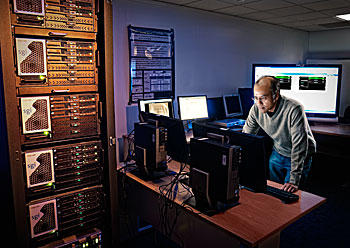Measurement Science to Support Advanced Communications Networks
(+$10 million)
Challenge

Broadband communications networks have become as essential to today's economy as the electrical power grid was to the Industrial Revolution. To compete effectively in this global business environment, communities and companies will need reliable, secure access to huge amounts of data, available anytime, anywhere. However, the U.S. currently lacks the technology to ensure adequate capacity to achieve a large-scale network capable of this vision.
This network will need to seamlessly integrate wireless and land-based communication technology, and it will rely on revolutionary advances in network architecture. Current networks are already showing signs of strain. There has been a 5,000 percent growth in demand for wireless internet data in the last three years. Currently, 3 percent of wireless smart-phone customers use up to 40 percent of the total available cell-phone bandwidth causing large bottlenecks in mobile broadband access.
Services are striving to address the rapid increase in demand, but new technologies and approaches are needed. Add to this the many new fields where reliable, efficient, secure, and low-cost networks are critical, such as medicine (e.g., Health IT, telemedicine), sensor and control networks (e.g., Smart Grid, environmental monitoring), and information systems (e.g., cloud computing), and it is clear that incremental advances in broadband technology or network capacity will be not be sufficient to meet the future needs of a hyperconnected world.
Proposed NIST Program
NIST modeling and measurement science will address three key areas to enable significant innovation in communications in both the commercial and public safety sectors:
Robust Next-Generation Network Technologies, +$4 million
A vast chasm exists between academic designs and commercially viable Internet-scale technologies. NIST will help bridge this gap by developing and employing advanced test and measurement techniques to characterize critical design requirements for next-generation Internet architectures. NIST also will work with industry to evaluate and improve emerging designs.
Signal Metrology for 21st-Century Communications, +$4 million
The latest wireless networks are capable of carrying gigabits of data per second. However, an essential technology—the ability to measure complicated signals at new bandwidths—is not available. NIST's ultrafast electro-optic measurement technology, an approach not currently in place for the wireless industry, can be used as a precision source of quality control for wireless communications, enabling Internet access at these potential high data rates. Working closely with industry, NIST will also use the requested funding for research to improve the capacity of fiber optic communications links.
700 MHz Public Safety Broadband Demonstration Network, +$2 million
There is clear need for a unified, interoperable public safety communications system to help the nation's first responders and other personnel respond most effectively to local, regional, and national emergencies. The Department of Commerce's Public Safety Communications Research program (conducted by NIST with the National Telecommunications and Information Administration) has created a 700 MHz Public Safety Broadband Demonstration Network to provide manufacturers a site for early deployment of their systems, to evaluate systems in a multi-vendor environment, and to stimulate integration opportunities for commercial service providers. The requested funding will support the continued operation of this facility.
Expected Impacts
Benefits expected from funding of this initiative include:
- a U.S. broadband network with potentially 10 or more times current capacity that requires only a marginal increase in capital and operating expenditures;
- progress in developing "frequency-agile" wireless systems based on intelligent hardware and faster microchips and other new technologies that take advantage of temporarily available spectrum; and
- establishment of a testbed and collaboration with the telecommunications industry to help in laying the groundwork for an interoperable public safety communications network that seamlessly delivers voice, data, and video to first responders and other emergency personnel through whatever communication avenues are available.

